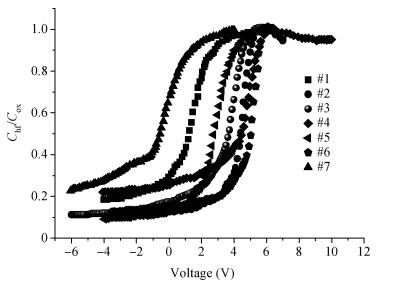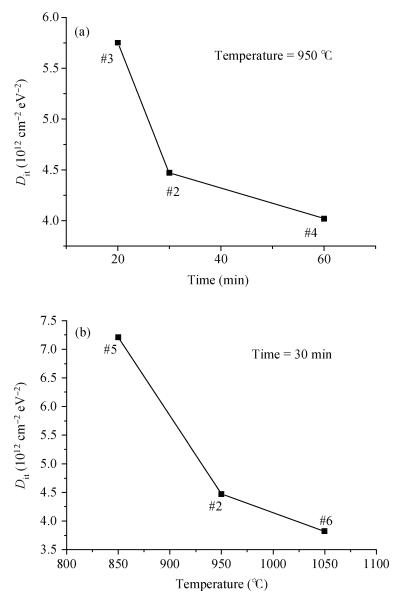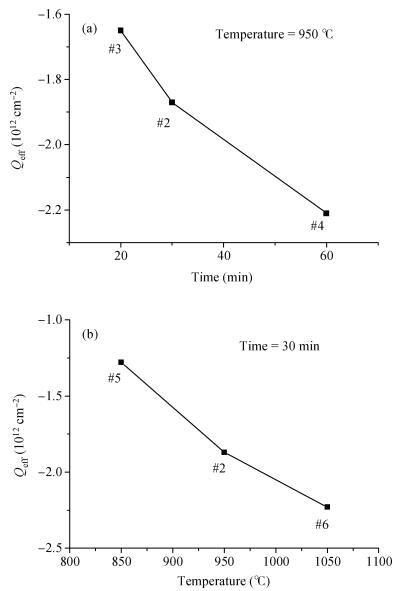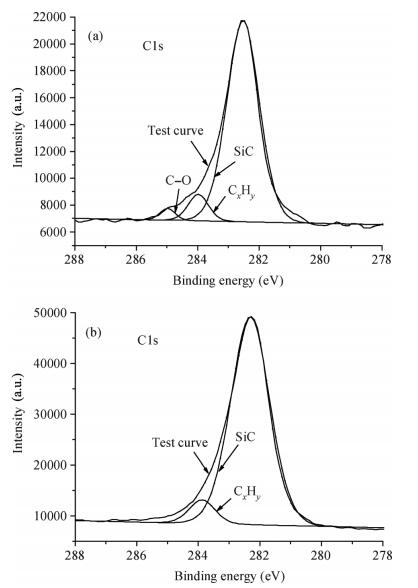| Citation: |
Hongli Yan, Renxu Jia, Xiaoyan Tang, Qingwen Song, Yuming Zhang. Effect of re-oxidation annealing process on the SiO2/SiC interface characteristics[J]. Journal of Semiconductors, 2014, 35(6): 066001. doi: 10.1088/1674-4926/35/6/066001
****
H L Yan, R X Jia, X Y Tang, Q W Song, Y M Zhang. Effect of re-oxidation annealing process on the SiO2/SiC interface characteristics[J]. J. Semicond., 2014, 35(6): 066001. doi: 10.1088/1674-4926/35/6/066001.
|
Effect of re-oxidation annealing process on the SiO2/SiC interface characteristics
DOI: 10.1088/1674-4926/35/6/066001
More Information
-
Abstract
The effect of the different re-oxidation annealing (ROA) processes on the SiO2/SiC interface characteristics has been investigated. With different annealing processes, the flat band voltage, effective dielectric charge density and interface trap density are obtained from the capacitance-voltage curves. It is found that the lowest interface trap density is obtained by the wet-oxidation annealing process at 1050℃ for 30 min, while a large number of effective dielectric charges are generated. The components at the SiO2/SiC interface are analyzed by X-ray photoelectron spectroscopy (XPS) testing. It is found that the effective dielectric charges are generated due to the existence of the C and H atoms in the wet-oxidation annealing process. -
References
[1] Zhu Zhiqiao, Wang Dejun. Effects of wet-ROA on shallow interface traps of n-type 4H-SiC MOS capacitors. Journal of Semiconductors, 2014, 35(2):024002 doi: 10.1088/1674-4926/35/2/024002[2] Lin C, Anant A, Sarit D, et al. Static performance of 20 A, 1200 V 4H-SiC power MOSFETs at temperatures of -187 to 300. J Electron Mater, 2012, 41(5):910 doi: 10.1007/s11664-012-2000-2[3] Fiorenza P, Swanson L K, Vivona M, at al. Comparative study of gate oxide in 4H-SiC lateral MOSFETs subjected to post-deposition-annealing in N2O and POCl3. Appl Phys A, 2014, 115:333 doi: 10.1007/s00339-013-7824-y[4] Zhang C X, Zhang E X, Fleetwood D M, et al. Origins of low-frequency noise and interface traps in 4H-SiC MOSFETs. IEEE Electron Device Lett, 2013, 34(1):117 doi: 10.1109/LED.2012.2228161[5] Yano H, Katafuchi F, Kimoto T. Effects of wet oxidation/anneal on interface properties of thermally oxidized SiO2/SiC MOS system and MOSFET's. IEEE Trans Electron Devices, 1999, 46(3):504 doi: 10.1109/16.748869[6] Sharma Y K, Ahyi A C, Isaacs-Smith T. High-mobility stable 4H-SiC MOSFETs using a thin PSG interfacial passivation layer, IEEE Electron Device Lett, 2013, 34(2):175 doi: 10.1109/LED.2012.2232900[7] Liu G, Ahyi A C, Xu Y, et al. Enhanced inversion mobility on 4H-SiC (1120) using phosphorus and nitrogen interface passivation. IEEE Electron Device Lett, 2013, 34(2):181 doi: 10.1109/LED.2012.2233458[8] Lin L M, Lai P T. Improved high-field reliability for a SiC metal-oxide-semiconductor device by the incorporation of nitrogen into its HfTiO gate dielectric. J Appl Phys, 2007, 102(5):054515 doi: 10.1063/1.2776254[9] Jamet P, Dimitrijev S. Physical properties of N2O and NO-nitrided gate oxides grown on 4H-SiC. Appl Phys Lett, 2001, 79(3):323 doi: 10.1063/1.1385181[10] Kosugi R, Umeda T, Sakuma Y. Fixed nitrogen atoms in the SiO2/SiC interface region and their direct relationship to interface trap density. Appl Phys Lett, 2011, 99(18):182111 doi: 10.1063/1.3659689[11] Schroder D K. Semiconductor material and device characterization. 2nd ed. New York:Wiley, 1998[12] Schürmann M, Dreiner S, Berges U. Investigation of carbon contaminations in SiO2 films on 4H-SiC(0001). J Appl Phys, 2006, 100(11):113510 doi: 10.1063/1.2399307[13] Chang K C, Nuhfer N T, Porter L M. High-carbon concentrations at the silicon dioxide-silicon carbide interface identified by electron energy loss spectroscopy. Appl Phys Lett, 2000, 77(14):2186 doi: 10.1063/1.1314293[14] Rudenko T E, Osiyuk I N, Tyagulski I P. Interface trap properties of thermally oxidized n-type 4H-SiC and 6H-SiC. Solid-State Electron, 2005, 49(4):545 doi: 10.1016/j.sse.2004.12.006[15] Da Silva C R S, Justo J F, Pereyra I. Crystalline silicon oxycarbide:is there a native oxide for silicon carbide. Appl Phys Lett, 2004, 84(24):4845 doi: 10.1063/1.1759373[16] Kamiya K, Ebihara Y, Chokawa K. Origins of negative fixed charge in wet oxidation for SiC. Materials Science Forum, 2013, 740:409 http://www.scientific.net/MSF.740-742.409 -
Proportional views






 DownLoad:
DownLoad:




















